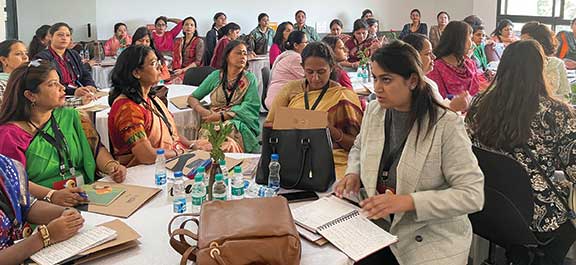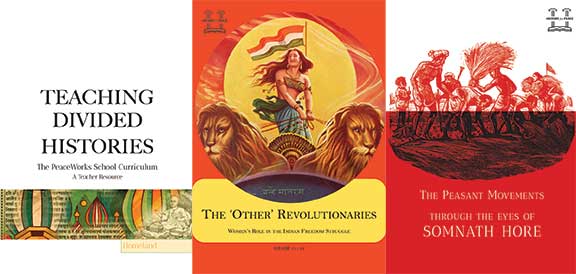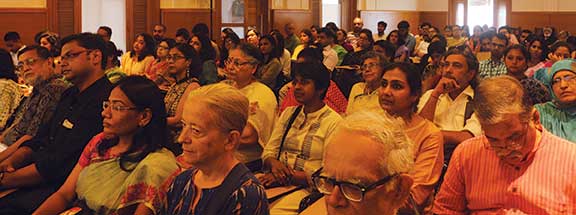Anchita Dasgupta
To the 15-year-old version of myself that nervously stepped into my school’s examination hall to take my first-ever history board exam in the spring of 2015, the idea of wantonly pursuing a seven-year-long, miserably-compensated research degree in history would have seemed ludicrous. Yet, less than a decade later, I sit at my desk, constantly refreshing my emails as I await a decision on my graduate school applications – a step towards realizing the dream of that PhD in history. Such a transformation can only be attributed to the curious but synergic mélange of an inspiring plus-two history teacher, an undergraduate degree in history mentored by faculty that rewarded lateral thinking at an institution that doesn’t bend to political propaganda, and a personal reckoning on the centrality of justice in my education and profession. The Indian high school history curriculum is ill-suited for such a mélange. Yet, at History for Peace, with our value-driven and vigorous commitment to the idea of peacebuilding through knowledge dissemination, we take what we have (the Indian education system), and transform it into a quiet revolutionary space – sowing the seeds of justice, empathy, and lateral thinking into the minds of high school students, through our network of passionate educators.
At a perfunctory glance, there is little intrinsically wrong with Indian history syllabi. On the ICSE board, students are taught the breadth of Indian history within a short span of four years. Class 9 begins with the Indus Valley Civilization that began in the South Asian Bronze Age (3340 BCE) while Class 12 ends with an introduction to the anti-dowry protests of the 1970s that trickle into contemporary gender-rights movements. What such a vast syllabus covers in breadth it lacks in depth. For instance, students can narrate the rights of minorities protected by the Indian Constitution without linking it to the structures of social, religious, and economic discrimination that the postcolonial government inherited from the British. They can describe Kwame Nkrumah’s role in the Ghanaian freedom struggle without being able to associate the similar role played by Jawaharlal Nehru in India.
Meanwhile, the CBSE-accredited schools, compelled to follow textbooks prescribed by the central education board (NCERT), are at constant peril of peddling state-sponsored propaganda. While the CBSE history syllabus has been weaponized for political ends right since its inception, the past pales in comparison to the recent government’s abrasive, cultural stranglehold over the NCERT. Under the fig leaf of decolonization, the conservative, right-wing government has launched a project to ‘nationalize’ Indian education – a smoke-and-mirrors initiative to erase the religious, cultural, and social syncretism that has shaped Indian history and arts under alternating centuries of foreign and local rule. Meanwhile, the caste-based, patriarchal, and exclusionary educational practices underlying ancient Hindu religious texts are glorified, while their shortcomings are swept under the rug. Recently, in April 2023, the central government launched a ‘rationalisation’ project to update the NCERT recommended syllabus in an effort to further inject its Hindu nationalist agenda into Indian classrooms. The new syllabi omits chapters on the Mughal empire, the rise of Islam in Asia in the fifth and sixth centuries, and anti-state, communist peasant movements in India post-Independence in an attempt to manufacture the narrative of a homogeneous, monolithic India that does not tolerate political, religious, or cultural aberration.

While the two boards contend with disparate challenges, the location of their syllabi within India’s rote-educational model compounds this failure. Incentivized by the desire to score well in board exams and earn a place into prestigious universities, students rely on learning from incomprehensible, poorly written textbooks, and reproduce answer keys in response to exam questions that are recurrently recycled by the boards. Teachers, who juggle multiple administrative responsibilities and finish teaching the expansive syllabus within the duration of a school year, support these strategic and shortcut ways to exam success. In the process, historical thinking is compromised – a skill that is yet to be introduced in our classrooms. The need to contextualize our history, to nurture an appreciation for its contemporary relevance, to foster an ability to empathize with alternative perspectives, and to question injustices of the past and its inevitable relationship with the present is passed over for hollow academic success. Students graduate high school with near-perfect exam scores without distinguishing fact from opinion and primary from secondary sources.
+++
History for Peace was born out of a conversation on the seed of personal and political conflict among colleagues at The Seagull Foundation for Arts. “Mindsets that unquestioned environmental prejudices had shaped seemed to be the root of the problem,” describes the director of History for Peace, and my colleague, Megha Malhotra. “They have seeped deep into the recesses of our subconscious; when triggered, they provoke us to react suddenly in biased, unkind ways.” Referring to the communal riots that broke out across the subcontinent on the eve of the British withdrawal, resulting in the humanitarian crisis of the Partition in 1947, she asks, “Why else would neighbours who had lived in perfect harmony with each other for years begin to kill one another without reason overnight?”
For nearly two decades, the Seagull Foundation has worked on peacebuilding through cultural initiatives directed primarily at school students across South Asia – India, Pakistan, Bangladesh and beyond – who were coming of age. Seagull’s PeaceWorks program ran storytelling projects at police schools in Kolkata, discussed the plight of Kashmiris under Indian rule through theatre-based exchange programs for Kashmiri and Indian students, and brought together thousands of school-going children from India and Pakistan at a peaceful kite-flying event at the Wagah border in 2007 commemorating 60 years since the Partition. In 2010, PeaceWorks won an award from the United Nations for its novel approach to peacebuilding. Therefore, the stage had already been set for a project that fuelled peace-building through historical thinking. By exposing young people to the unseen realities and unheard voices of past conflict, and acknowledging the history at the root of our fractured social structure, History for Peace teaches young people to heal through empathetic and mindful engagement with history. “The aim is to consciousness-build through education so that when young adults step out of their schools into their first voting booths, they exercise their rights responsibly because they understand the magnitude of what is at stake,” says Malhotra.
Unsurprisingly, therefore, some of the earliest work that came out of History for Peace was directed at the Partition. The first annual History for Peace conference in 2015 put into conversation partition historians from across the subcontinent – Urvashi Butalia from India, Mubarak Ali from Pakistan, and Afsan Chowdhury from Bangladesh, among others. The goal of the conference was to extend materials, insights, and knowledge to school-level educators that were missing in their textbook pedagogy. The Partition itself is a glaring gap in most Indian syllabi; although the colonial and postcolonial history of India is elaborated at great length, Indian students do not formally learn of the largest refugee crisis faced by humankind without stepping into a college-level history course. The conference discussed the necessity of introducing the Partition in history classes, integrating literature and art on the Partition into history lessons, and embedding the voices of minorities – such as women – into its mainstream discourse. Similarly, one of the first teaching modules produced by History for Peace, showcased by the British Council in Londonderry, was also on the Partition. Entitled Teaching Divided Histories, the resource cumulated excerpts on narrative-style writing on the personal experiences of displacement during the Partition, images from the partition of 1947 and the liberation of Bangladesh in 1971, and activity ideas that attempted to draw parallels between personal experiences of conflict and resistance in South Asia to other periods and areas of global history. The module was an instant success and continues to be in use eight years later and can be downloaded from the History for Peace website.
+++

Since 2015, History for Peace has grown in scale, hosting eight annual conferences (the most recent one was titled ‘The Idea of Democracy’) with public intellectuals such as Gayatri Spivak, Romila Thapar, Arvind Narain, Krishna Kumar, and A.G. Noorani among others. Additionally, regional conferences, workshops, talks, lesson plans, and teaching modules curated by HfP have buttressed a plethora of topics that are typically studied in the Indian history classroom. HfP’s resources – particularly teaching modules that delineate lesson plans, project ideas, questions for discussion, and further reading on Indian history topics – are directed primarily at high school teachers. These modules aspire to meet one or both of two goals – to incorporate the voice of the subaltern other to challenge the dominant, biased narrative of mainstream history and to read the arts – literature, film, photography, and paintings – as sources of history. Both of these resources train students to confront social and internal biases, understand power in knowledge production, and seek peace and justice through history education.
The ‘Other’ Revolutionaries: Women’s Role in the Indian Freedom Struggle, a module produced by HfP begins by identifying the male-dominated discourse of history worldwide that erases histories written and experienced by non-men. Prefacing the lesson with the key conceptual difference between gender and sex as identified by queer and feminist theorists, the module delves into the gendered experiences of colonialism and anti-colonial resistance, unpacking the heteropatriarchal ideas of nationalism innate in concepts like that of Bharat Mata. Histories of women revolutionaries ignored in high school textbooks such as the stories of Pritilata Waddedar, Rani Gaidinliu and Lakshmi Sehgal are used to provoke a discussion on the politics of ‘what and who we remember and what and who we choose to forget.’ The module urges students to fill in the gaps in history – encouraging them to peruse local archives for histories of forgotten revolutionaries and extend the premise of erasure of marginalized voices to other contexts. One recommended activity encourages students to consider the contributions of gender minorities to the freedom struggles in Latin America, Afghanistan and Palestine. The goal of the module is to politicize private spheres and read oral histories that are not conventionally seen as history sources by students and apply critical historiographical tools to other experiences and contexts in their lives.
HfP also produces teaching modules that embed art and literature into mainstream history. For instance, through the module titled The Peasant Movement through the Eyes of Somnath Hore, HfP attempts to document the histories of two communist-led peasant movements through the work of painter-sculptor Somnath Hore. The module uses Hore’s sketches and notes on peasant movements – particularly the Tebhaga Movement and the Darjeeling Tea Garden workers’ movement – to examine the rise of communism at the end of colonial rule.
The module draws from the NCERT-recommended history books that discuss anti-colonial peasant movements, excerpting segments discussing British agricultural policies through the decades, the rise of zamindars, and the oppression of peasants under their tyranny. Hore’s sketches of peasant leaders and his accounts of their stories of defiance against the British police provide a ground-up, pictorial depiction of dry textbook passages. Through this module, an alternative and disempowered voice of mainstream history is centred – the voice of the peasant revolutionary, and a source that is commonly perceived as politically biased and subjective – the diary of a communist artist – is viewed as a source of history. The goal of this module is to employ historical thinking to politicize the everyday, to portray the obscure and erased as central aspects of historical scholarship, and to perceive art and literature as tools of scholarship and politics.
Amidst an increasingly stifling political environment, the ability of such modules to effect a change in mindsets at culturally conservative, success-driven, and profit-oriented educational institutions is limited. Our recourse is to rely on our vast network of teachers – to instil in them a sense of political responsibility, alert them to the extent of power they wield over young minds, urge them to see beyond the immediacy of completing board exam syllabi and awaken them to the urgency of sowing the seeds of empathy, justice, and critical thought in their classroom, that will shape the history their students write.
Thus, one of our largest upcoming projects, titled The Syllabus Archive, aims to make our idealistic goals of history education more accessible to teachers, who are operating within the strangling constraints of time, resources, and exposure. The archive will put together alternative history syllabi for ICSE and CBSE boards from classes 7 to 12 pooling all the material that has been developed by HfP over the past decade. It includes teacher workshops on different chapters from the syllabus that demonstrate how to teach existing topics with the materials that HfP recommends. Additionally, it will propose project ideas for each chapter and foster an online space for students to reflect upon alternative perspectives on topics related to the syllabi.
+++

Perhaps the biggest challenge confronting a project like History for Peace is its choice to focus exclusively on elite students and resource-rich schools. Not only does this raise the legitimate and recurrent concern of creating an echo-chamber effect, but it also impedes access to donors and grants that support similar educational initiatives directed at government-run public schools. Yet, as a former volunteer teacher at an international NGO that worked in the public education sector in India, I cannot help but argue for the necessity of the work conducted by HfP.
Given the inequality of access to education and income in our country, it is not pragmatic to introduce critical theoretical approaches to historical study in classrooms where mid-day meals are the central focus of the school day, and child marriage and child trafficking are the leading factors behind skyrocketing dropout rates. The overwhelming majority of those who work in the non-profit education sector seek to alter these problems by working with students from the lowest rungs of the socio-economic ladder.
Meanwhile, abysmally little is done to educate students who hold power and privilege, who graduate from high school and walk into positions of power and wealth with little cognizance of their positionality. These are the high schools that History for Peace targets in its work. “These are the children who will someday have the resources and power to effect change. It is in their minds that we seek to instill empathy, create awareness of positionality, and a sense of historical thinking,” says Malhotra explaining the foundation’s intentional choice to work primarily with ICSE and CBSE schools instead of state board schools with vernacular languages of instruction.
In addition to changing mindsets and subverting dominant modes of history, History for Peace, through its mission of peacebuilding through education, is quietly, yet materially subverting the power structure within which history is written and disseminated. By pushing the powerful to confront biases, study with empathy, and seek justice, History for Peace demonstrates the revolutionary ability of history education to transform structures and mindsets in society and channel power into equitable and productive ends.
The author is a research intern at History for Peace, Seagull Foundation for the Arts. She holds an undergraduate degree in History and Middle East Studies from Brown University and an MPhil in Law from the University of Oxford. She can be reached at anchita.dasgupta@gmail.com.
